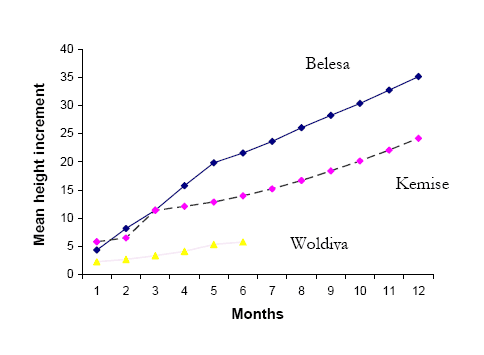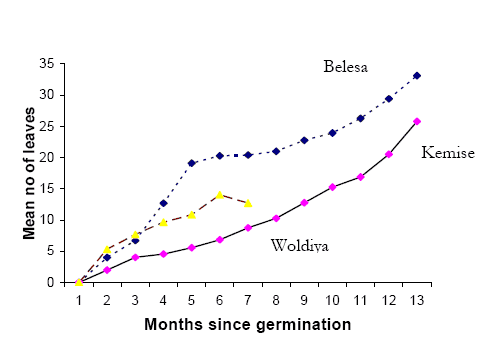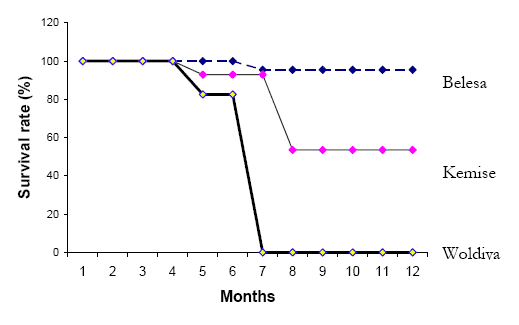


by
Solomon Gebreyohannis24
Neem has been introduced to almost all tropical and subtropical regions (Schumutterer, 1998), but is still rare in Ethiopia, where it is found only in one place, Metema, in the northwest of Amhara National Regional State (ANRS), in the north of the country. The origin of the seed is undocumented, but the tree appears to grow well. Cultivating neem in other dry and degraded areas of the Amhara region has been suggested (Vietrneyer, 1992), but this will entail the establishment of provenance trials (which would include the local provenance), and the identification of the most adapted provenances according to the plantation objective (soil conservation, provision of natural pesticide to farmers, etc). Before new germplasm is imported for testing, knowledge of neem seed handling, treatment and cultivation in the nursery and in plantation is necessary. The present paper reports on the first introduction of the local neem provenance to three sites in Amhara in 1999. Seedlings behaviour was assessed and basic conclusions drawn for the future establishment of provenance trials.
Neem seeds were hand picked from the ground in Dire Dawa. They were depulped and washed by hand. Seed collection was done during the late fruit ripening season (July-August). The seeds were half sun dried and stored in a light sieved cloth (“Netella”).
The three sites, Belesa, Kemise and Woldiya are located at 12º 25’ 12” N and 38º 02’ 24” E; 10º 38’ 40” N and 39º 38’ 40” E; and 11º 45’ 36” N and 39º 33’ 36” E respectively.
Table 1. Site conditions
Annual Average |
|||||
Sites |
Elevation(m) |
Rainfall(mm) |
Mean monthly temp.(0c) |
Soil type |
|
Belesa |
1900 |
1030 |
20-25 |
Clayey eurthric regosol |
|
Kemise |
1450 |
950 |
19.36 |
Silty clay euthric regosol |
|
Woldiya |
1800 |
1053 |
15-20 |
Black cotton chromic vertisol |
|
In the nursery, seedlings were raised on 10 cm high beds. Pits were dug at 10 cm x 5 cm spacing and 3 seeds inserted in a pit. Planting was done in the surroundings of the nursery site with two replications. Each block had two lines and 25 seedlings per line. Pits (30 cm x 30 cm in depth & width) were open 15 days before planting, at spacing of 1 m x 1 m, according to a complete block design.
In the nursery, after sowing, seedlings were assessed every 2 weeks. After 4 months, 25 randomly selected seedlings, according to the methodology suggested by Wood and Burley (1991), were outplanted in the field. At the planting site, survival rate, height and number of leaves were recorded every 15 days for 8 months.
A X2 test was used to assess the significance of differences in germination and survival rates between sites. A T-test checked significant differences in height and number of leaves between two sites; and a F- test was used to discriminate the three sites.
In the nursery, germination and survival rates were significantly different between the three sites at α=0.05 (table 2). Since seedlings at Woldiya appeared damaged at month seven since germination, data on three sites was analyzed at the age of six months and significant differences found. At the end of the year, results at two sites (Belesa and Kemise) also showed significant difference (T-test at α = 0.05).
Table 2. Germination and survival rates and length of dormancy in nursery sites.
Sites |
Germination energy (%) |
Survival rate (%) |
Dormancy period1 |
Belesa |
93.67 |
85.41 |
22 |
Kemise |
40.14 |
88.39 |
16 |
Woldiya |
11.00 |
63.34 |
24 |
1Dormancy in number of days elapsed between sowing and germination.
In both nursery and plantation, eurithric regosols (found at Belesa and Kemise) appeared more favorable to neem than black vertisols (found at Woldiya).

![]()

![]()

Fig. 3. Survival rates at planting sites
The study shows that neem seed processing, treatment and handling can be done relatively easily in Ethiopia. Sites Belesa and Kemise show the most interesting potential for further neem introduction and testing. The study widens the limits of neem cultivation usually recommended (Vietrneyer, 1992) (elevations lower than 1200 m and average annual rainfall below 400 mm), although adult plant behavior will need to be assessed before final conclusions are drawn. In the limits of the study, seven-month old neem seedlings have successfully grown at 1900 m a.s.l. and under 1000 mm annual rainfall. In these conditions, heavy clay soils appear unsuitable for the local provenance. In future experiments, it will be necessary to test the behavior of the local provenance against other known provenances, as was done in Tanzania (Iversen et al., 2002).
The author would like to thank the Ethiopian Science and Technology Commission for sponsoring the research. The Commission for Sustainable Agriculture and Environmental Rehabilitation in Amhara Region (Co-SAERAR) supported the study with office facilities.
Iversen, P., Svejgaard Jensen J. and Mtika J. 2002. Assessment of four neem (Azadirachta indica) international provenance trials in Tanzania. Forest Genetic Resources No 30. FAO, Rome, Italy.
Saxena, R.C. 1994. The neem tree: Its Potential for Developing Countries. Global Pesticide Campaigner, Vol. 4, No.2, Kenya.
Schmutterer, H. 1998. Origin, Geographical Distribution and Use of the Neem Tree Azadirachta indica a Worldwide Overview. Pp. 27-32. In: Proceeding of the potential of the Neem Tree in Ghana, Dodowa, Ghana, GTZ.
Veitrneyer, N. 1992. Neem: A Tree for Solving Global Problems. Report on Ad-Hoc Panel of the Board on Science and Technology for International Development, National Research Council, National Academy Press, Washington, D.C.
Wood, P.J. and J. Burley. 1991. A Tree for all Reason – The Introduction and Evaluation of Multipurpose Trees for Agroforestry. ICRAF, Nairobi, Kenya.
Zar, J.H. 1984. Biostatistical Analysis (2nd ed.). Prentice-Hall, Englwood Cliss, Newjercy.
Note from the Editors: the publications of the International Neem Network, including technical guidelines on seed collection and exchange and seed sources description, have been digitalized and are available on line at www.fao.org/forestry/site/5313/en.
24 Sirinka Agricultural Research Center, P.O.box 74, Woldiya, Ethiopia, email: [email protected]